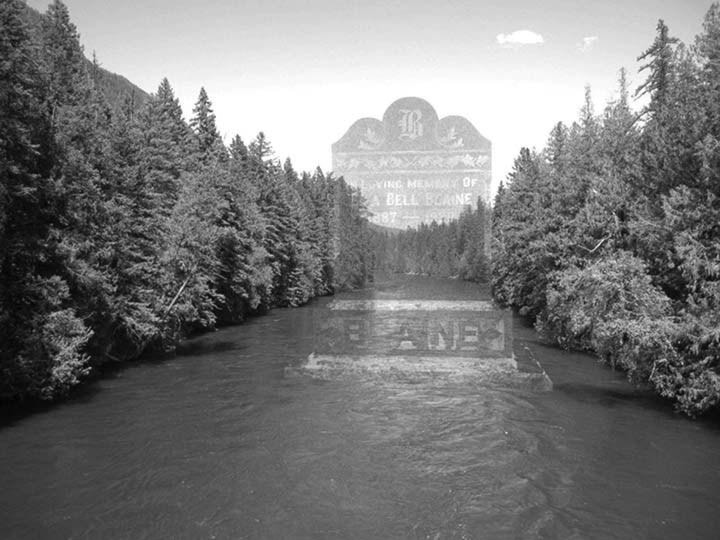Jim Cameron
There is neither a river nor a creek of any note in the Kootenays that has not taken the life of some unsuspecting, unfortunate or over-confident individual. The St. Mary's River has certainly accounted for her share.
One of the first recorded deaths on the St. Mary's occurred in May, 1906, when Tom Wallace, a young man attempting to ford the mouth of the river on horseback, was thrown by his panicked steed and drowned.
In July 1907, J. McLeod and J. Lewis, two young workers at the Marysville smelter, decided to cross the river near Marysville to try their luck at prospecting. Their small boat overturned and they were both swept to their death. In a further addition to the tragedy, a young search party volunteer by the name of Thomas Thomas at one point attempted to wade the river and was also carried away to his demise. His body was later located near the St. Eugene Mission.
For many years it was only men who lost their lives in the local waters. That would change on June 20, 1920.
It was a warm summer Sunday on the afternoon when Mr. and Mrs. A.C. Blaine, Mr. and Mrs. Archie Moe, and Mr. and Mrs. Wilber Hill along with their young son left Cranbrook to motor to the popular camping area at St. Mary's Lake. Just a picnic and return to town the same night.
About 8 p.m. that evening, shortly before the group was to return to town, Mrs. Blaine, Mr. and Mrs. Moe, high school student Faith Ewen and 12-year-old Thelma Herrett joined Thelma's father, Otis Herrett, for a boat tour of the lake. Mr. Herrett had just recently purchased the summer camp and was no doubt eager to show off the rental boats equipped with gasoline engines. Mr. Blaine elected to stay ashore as did the Hill family whose little boy was frightened of the noise of the boat engine.
As the boat cast off it appeared to become entangled in the rocks near shore which may have damaged the rudder manned by Thelma Herrett. In a further quirk of fate, as the craft attempted to make the landing near where the lake empties into the St. Mary's River, the engine died.
With a faulty rudder, no engine and an unfortunate lack of oars the craft quickly drifted towards the river, its waters swollen by a recent warm spell.
To those watching from the shore it became rapidly apparent that the boat and its occupants were in serious trouble; helpless sailors in a hapless craft helmed by deadly fortune.
The end came all too quickly in the wildly rushing river. Onshore Mr. Hill, seeing their difficulty, rushed to the breakwater timbers to pass a small clothesline rope to the craft as it went by. Mr. Moe was standing upright in the boat attempting to keep her steady and assuring the group that all would be well. The line was caught by one of the passengers but despite holding with all his strength the rope slipped through Mr. Hill's grasp.
Witnesses watched in dismay as the boat sped under the bridge, down a straight stretch and passed out of sight around a bend.
The craft, recovered a short time later some distance away, was upside down with Otis Herritt clinging to it in a state of near unconsciousness. Mr. Moe had made it safely to shore. He re-entered the water to search for his wife but found instead the lifeless body of Thelma Herrett. She was brought to the riverbank where lifesaving efforts proved futile. Miss Ewen had the presence of mind to grasp an overhanging branch and swing to safety, a move that some said may have capsized the boat. Upon reaching shore she witnessed Mrs. Blaine floating unconscious on the surface of the water for a short time and then sink below.
Large search parties quickly formed but were hampered by the rapidly dwindling light. Daybreak found hundreds of men searching the river. Local, provincial and mounted police dragged the waterway with grappling hooks but to no avail. The weather warmed and the river rose. A special boat built at Wycliffe and manned by six experienced river divers failed to turn up any clues. In early July the bereaved husbands posted a joint $500.00 reward for the recovery of their wives bodies but the river refused to give up her dead. It was late July before Mrs. Blaine’s body was discovered about a mile below the Wycliffe Bridge. Identification was established by means of a ring worn by the deceased. In mid-August Mrs. Moe’s brother-in-law, continuing to search tirelessly, found her body about three miles below the scene of the accident. There was no individual blame attached to any of the members of the unfortunate party but steps were taken to ensure the future safety of boaters on the lake. It was neither the first nor the last tragedy along the St. Mary’s river but for the small, tightly-knit community of Cranbrook, the loss of a young girl and two women in their early thirties was deeply felt.
Both Thelma Olivia Herrett and Lila Bell Blaine lay in the Old General Cemetery. Following a local funeral Mrs. Moe was taken to her home town of Lethbridge for interment.
Armond Clarke Blaine remarried in 1921 and that same year opened the Star movie theatre on 10th Ave. (now Royal LePage East Kootenay Realty). In 1952 he opened a new theatre on the site of the former city Auditorium. He died shortly before it was completed and his wife named it “The Armond” in his honour.
